Abstract
Functional domains in the RepI replication initiator protein have been identified by classical and site-directed mutagenesis techniques. Mutations conferring an increase in plasmid copy number contained alterations in a key position of a putative helix-turn-helix DNA binding motif. The mutations did not appear to affect autorepressing functions. Regions of RepI important for autorepression were localized as well. Two classes of mutations resulting in diminished autorepression functions were identified. One class was distinguished by an elevated copy number, while the other class remained at the wild-type copy number level. Analysis of the various mutations leading to changes in copy number or autorepressing functions suggest that in some cases the autorepression and initiating functions of the RepI protein are separable. Finally, analysis with deletion clones suggests that the trans-acting autorepressing functions of RepI might depend on intermolecular coupling control.
Full text
PDF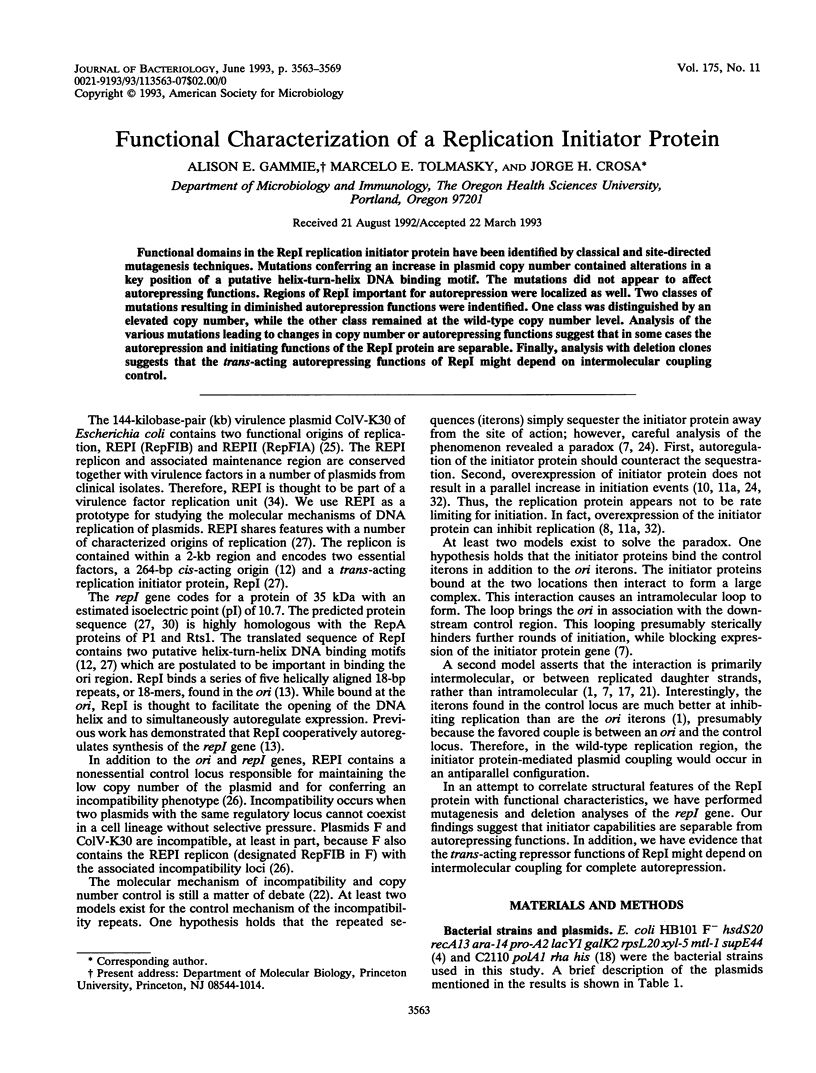
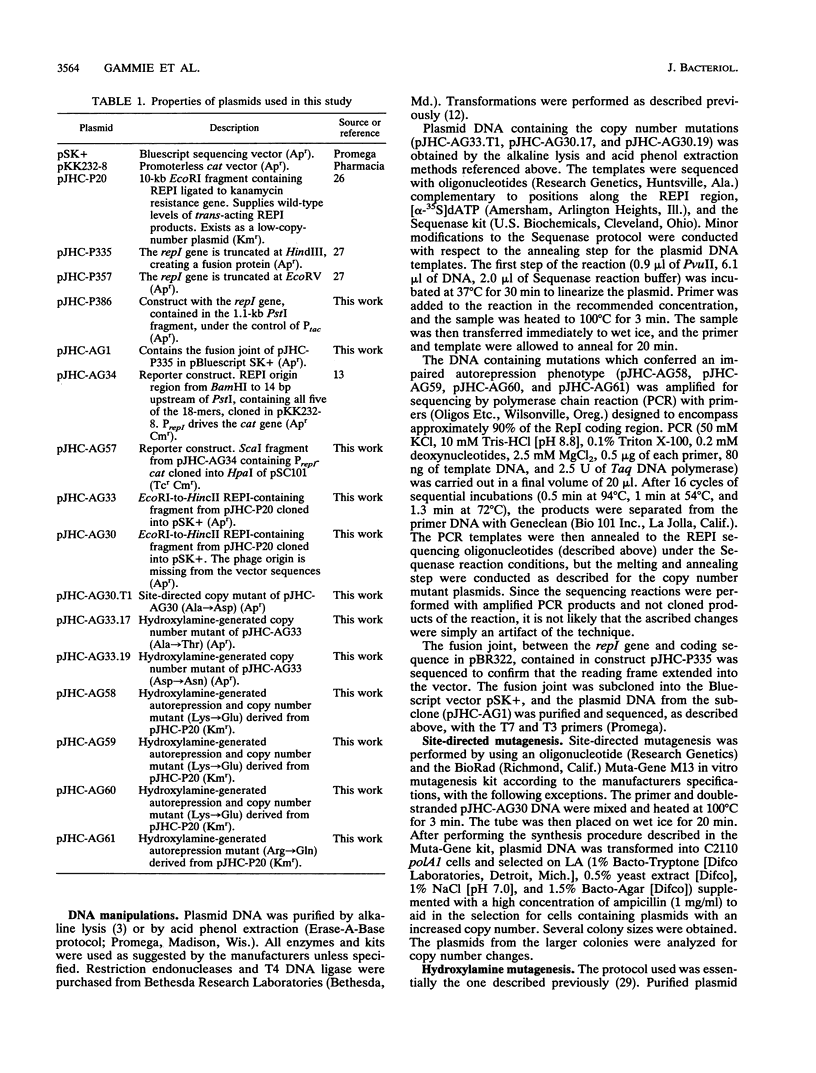
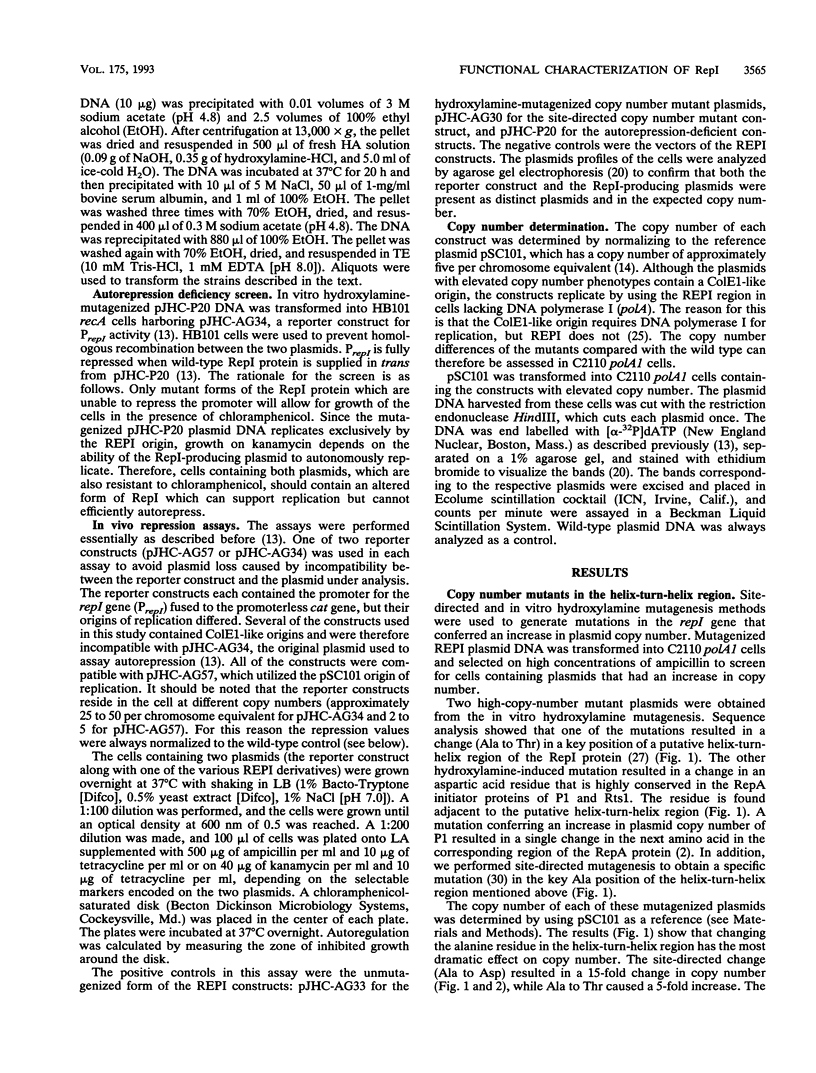
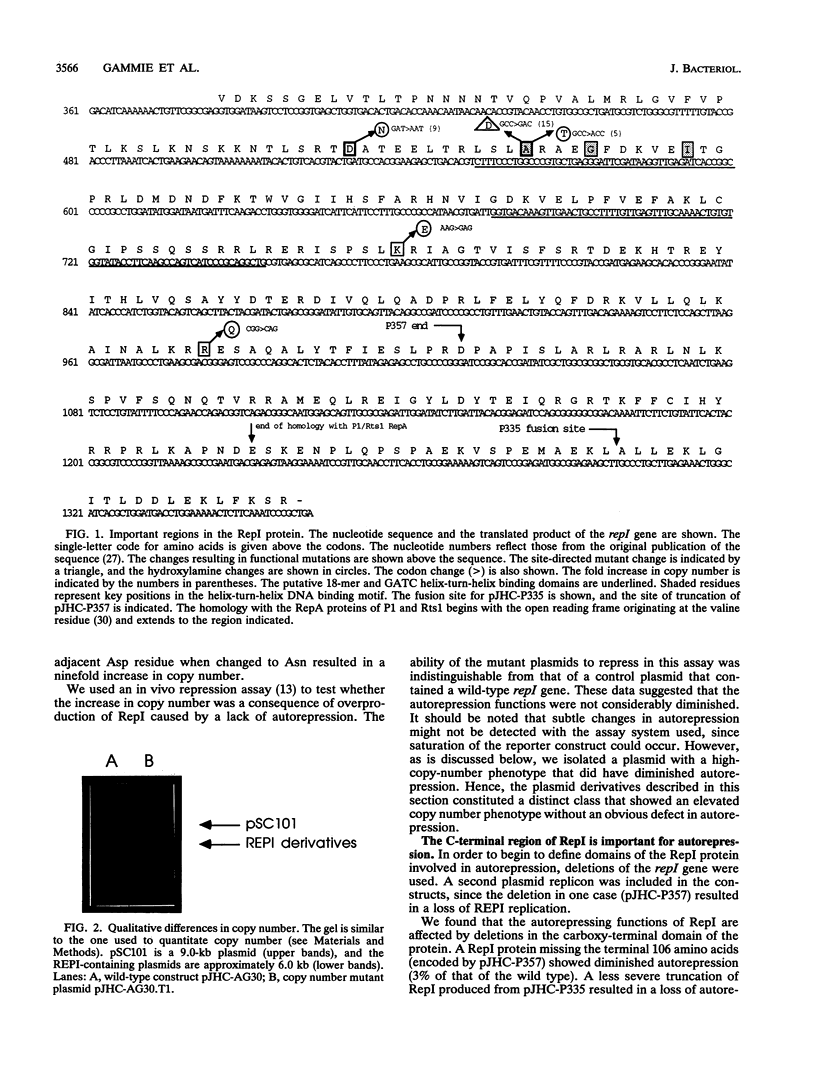
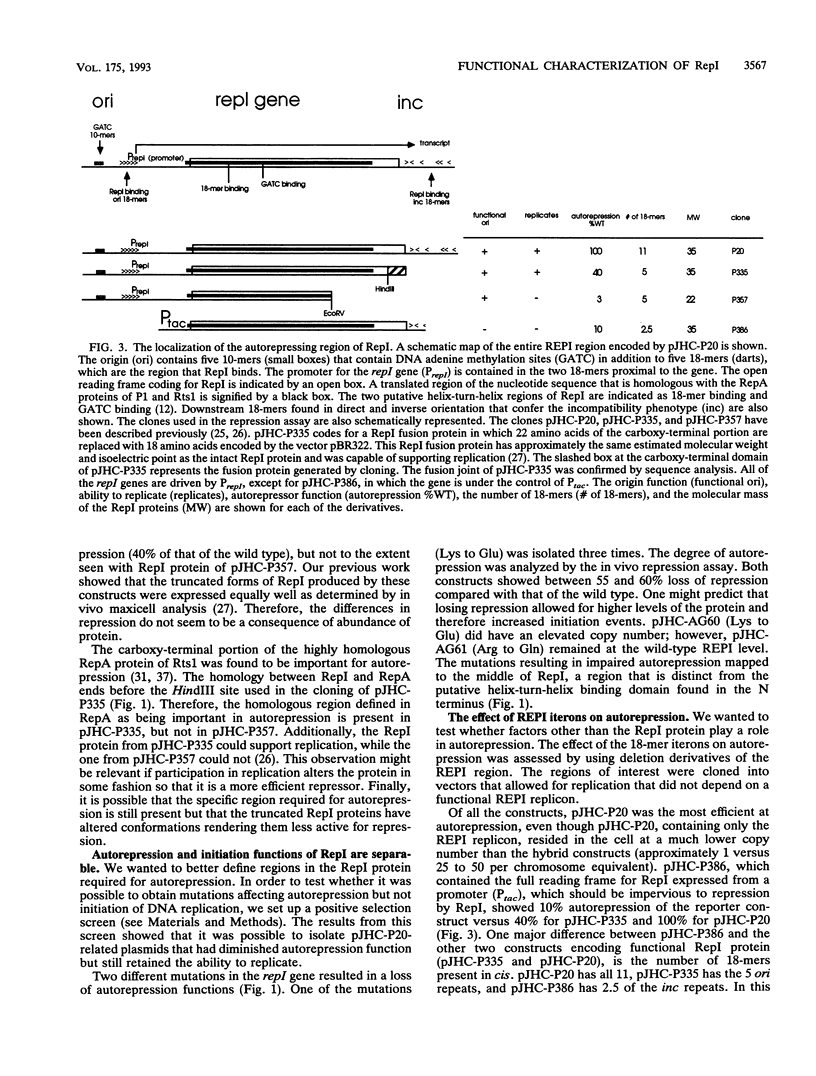
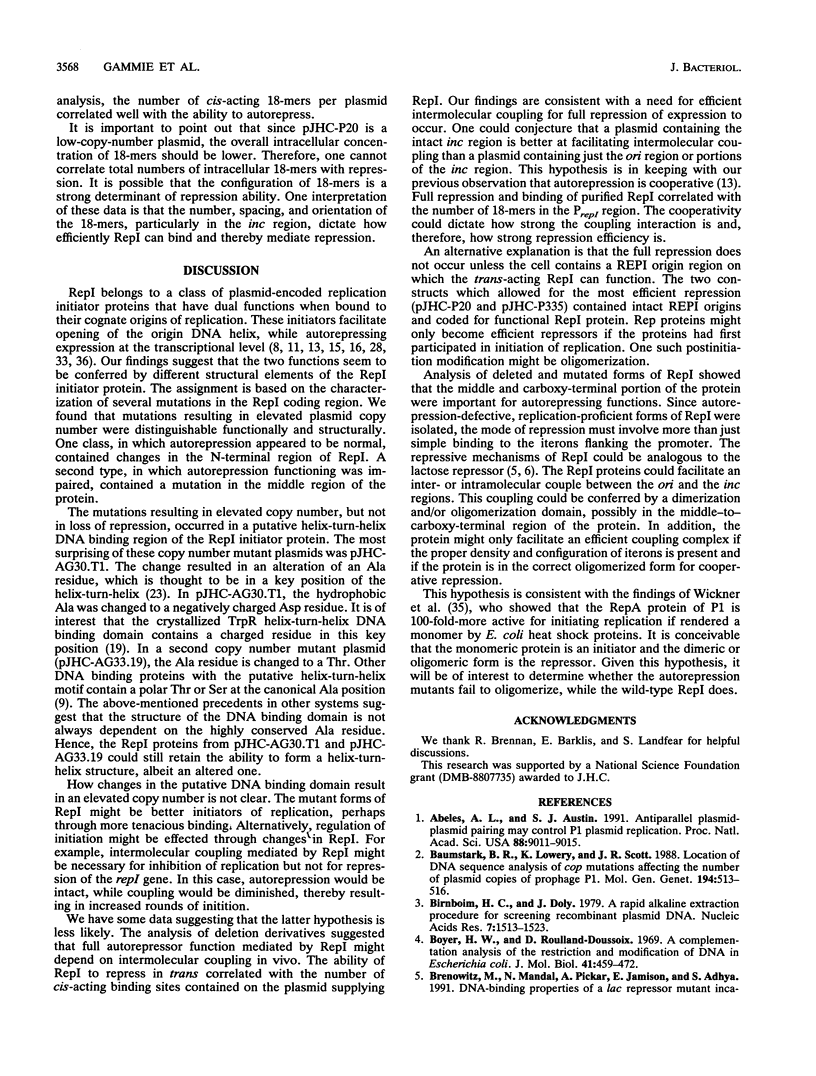
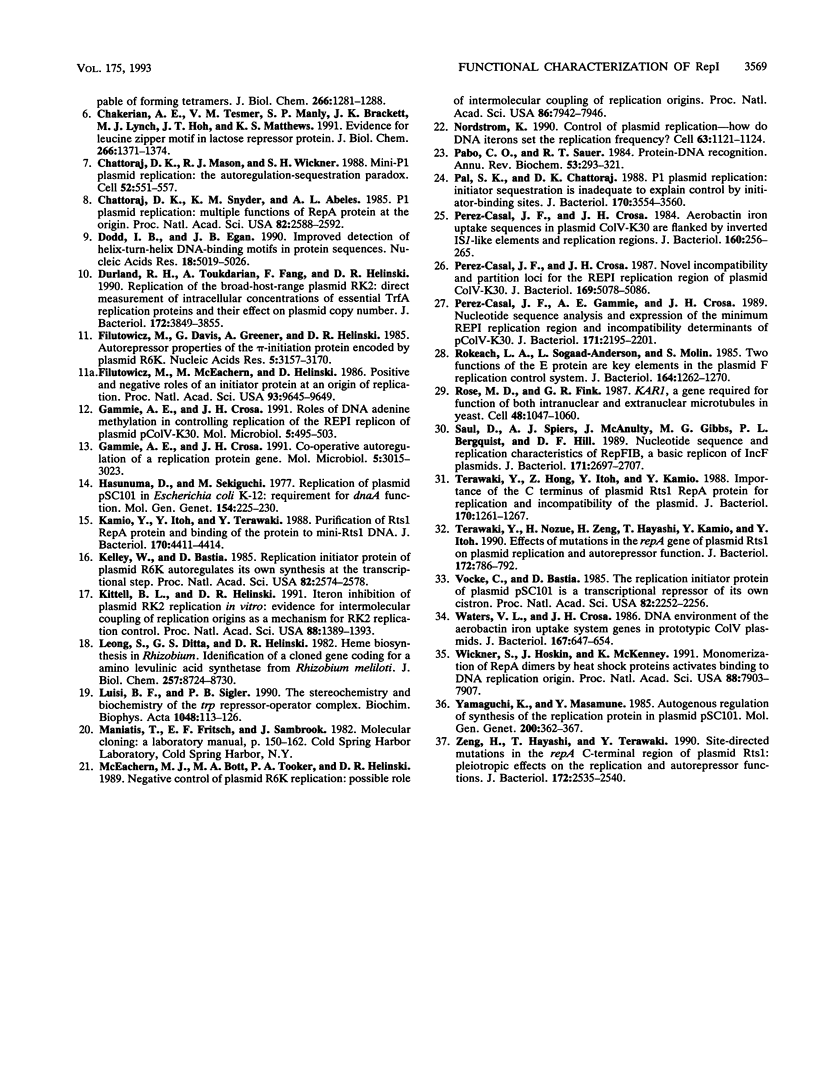
Images in this article
Selected References
These references are in PubMed. This may not be the complete list of references from this article.
- Abeles A. L., Austin S. J. Antiparallel plasmid-plasmid pairing may control P1 plasmid replication. Proc Natl Acad Sci U S A. 1991 Oct 15;88(20):9011–9015. doi: 10.1073/pnas.88.20.9011. [DOI] [PMC free article] [PubMed] [Google Scholar]
- Baumstark B. R., Lowery K., Scott J. R. Location by DNA sequence analysis of cop mutations affecting the number of plasmid copies of prophage P1. Mol Gen Genet. 1984;194(3):513–516. doi: 10.1007/BF00425567. [DOI] [PubMed] [Google Scholar]
- Birnboim H. C., Doly J. A rapid alkaline extraction procedure for screening recombinant plasmid DNA. Nucleic Acids Res. 1979 Nov 24;7(6):1513–1523. doi: 10.1093/nar/7.6.1513. [DOI] [PMC free article] [PubMed] [Google Scholar]
- Boyer H. W., Roulland-Dussoix D. A complementation analysis of the restriction and modification of DNA in Escherichia coli. J Mol Biol. 1969 May 14;41(3):459–472. doi: 10.1016/0022-2836(69)90288-5. [DOI] [PubMed] [Google Scholar]
- Brenowitz M., Mandal N., Pickar A., Jamison E., Adhya S. DNA-binding properties of a lac repressor mutant incapable of forming tetramers. J Biol Chem. 1991 Jan 15;266(2):1281–1288. [PubMed] [Google Scholar]
- Chakerian A. E., Tesmer V. M., Manly S. P., Brackett J. K., Lynch M. J., Hoh J. T., Matthews K. S. Evidence for leucine zipper motif in lactose repressor protein. J Biol Chem. 1991 Jan 25;266(3):1371–1374. [PubMed] [Google Scholar]
- Chattoraj D. K., Mason R. J., Wickner S. H. Mini-P1 plasmid replication: the autoregulation-sequestration paradox. Cell. 1988 Feb 26;52(4):551–557. doi: 10.1016/0092-8674(88)90468-0. [DOI] [PubMed] [Google Scholar]
- Chattoraj D. K., Snyder K. M., Abeles A. L. P1 plasmid replication: multiple functions of RepA protein at the origin. Proc Natl Acad Sci U S A. 1985 May;82(9):2588–2592. doi: 10.1073/pnas.82.9.2588. [DOI] [PMC free article] [PubMed] [Google Scholar]
- Dodd I. B., Egan J. B. Improved detection of helix-turn-helix DNA-binding motifs in protein sequences. Nucleic Acids Res. 1990 Sep 11;18(17):5019–5026. doi: 10.1093/nar/18.17.5019. [DOI] [PMC free article] [PubMed] [Google Scholar]
- Durland R. H., Helinski D. R. Replication of the broad-host-range plasmid RK2: direct measurement of intracellular concentrations of the essential TrfA replication proteins and their effect on plasmid copy number. J Bacteriol. 1990 Jul;172(7):3849–3858. doi: 10.1128/jb.172.7.3849-3858.1990. [DOI] [PMC free article] [PubMed] [Google Scholar]
- Filutowicz M., McEachern M. J., Helinski D. R. Positive and negative roles of an initiator protein at an origin of replication. Proc Natl Acad Sci U S A. 1986 Dec;83(24):9645–9649. doi: 10.1073/pnas.83.24.9645. [DOI] [PMC free article] [PubMed] [Google Scholar]
- Gammie A. E., Crosa J. H. Co-operative autoregulation of a replication protein gene. Mol Microbiol. 1991 Dec;5(12):3015–3023. doi: 10.1111/j.1365-2958.1991.tb01861.x. [DOI] [PubMed] [Google Scholar]
- Gammie A. E., Crosa J. H. Roles of DNA adenine methylation in controlling replication of the REPI replicon of plasmid pColV-K30. Mol Microbiol. 1991 Feb;5(2):495–503. doi: 10.1111/j.1365-2958.1991.tb02133.x. [DOI] [PubMed] [Google Scholar]
- Hasunuma K., Sekiguchi M. Replication of plasmid pSC101 in Escherichia coli K12: requirement for dnaA function. Mol Gen Genet. 1977 Sep 9;154(3):225–230. doi: 10.1007/BF00571277. [DOI] [PubMed] [Google Scholar]
- Kamio Y., Itoh Y., Terawaki Y. Purification of Rts1 RepA protein and binding of the protein to mini-Rts1 DNA. J Bacteriol. 1988 Sep;170(9):4411–4414. doi: 10.1128/jb.170.9.4411-4414.1988. [DOI] [PMC free article] [PubMed] [Google Scholar]
- Kelley W., Bastia D. Replication initiator protein of plasmid R6K autoregulates its own synthesis at the transcriptional step. Proc Natl Acad Sci U S A. 1985 May;82(9):2574–2578. doi: 10.1073/pnas.82.9.2574. [DOI] [PMC free article] [PubMed] [Google Scholar]
- Kittell B. L., Helinski D. R. Iteron inhibition of plasmid RK2 replication in vitro: evidence for intermolecular coupling of replication origins as a mechanism for RK2 replication control. Proc Natl Acad Sci U S A. 1991 Feb 15;88(4):1389–1393. doi: 10.1073/pnas.88.4.1389. [DOI] [PMC free article] [PubMed] [Google Scholar]
- Leong S. A., Ditta G. S., Helinski D. R. Heme biosynthesis in Rhizobium. Identification of a cloned gene coding for delta-aminolevulinic acid synthetase from Rhizobium meliloti. J Biol Chem. 1982 Aug 10;257(15):8724–8730. [PubMed] [Google Scholar]
- Luisi B. F., Sigler P. B. The stereochemistry and biochemistry of the trp repressor-operator complex. Biochim Biophys Acta. 1990 Apr 6;1048(2-3):113–126. doi: 10.1016/0167-4781(90)90047-6. [DOI] [PubMed] [Google Scholar]
- McEachern M. J., Bott M. A., Tooker P. A., Helinski D. R. Negative control of plasmid R6K replication: possible role of intermolecular coupling of replication origins. Proc Natl Acad Sci U S A. 1989 Oct;86(20):7942–7946. doi: 10.1073/pnas.86.20.7942. [DOI] [PMC free article] [PubMed] [Google Scholar]
- Nordström K. Control of plasmid replication--how do DNA iterons set the replication frequency? Cell. 1990 Dec 21;63(6):1121–1124. doi: 10.1016/0092-8674(90)90405-4. [DOI] [PubMed] [Google Scholar]
- Pabo C. O., Sauer R. T. Protein-DNA recognition. Annu Rev Biochem. 1984;53:293–321. doi: 10.1146/annurev.bi.53.070184.001453. [DOI] [PubMed] [Google Scholar]
- Pal S. K., Chattoraj D. K. P1 plasmid replication: initiator sequestration is inadequate to explain control by initiator-binding sites. J Bacteriol. 1988 Aug;170(8):3554–3560. doi: 10.1128/jb.170.8.3554-3560.1988. [DOI] [PMC free article] [PubMed] [Google Scholar]
- Perez-Casal J. F., Crosa J. H. Aerobactin iron uptake sequences in plasmid ColV-K30 are flanked by inverted IS1-like elements and replication regions. J Bacteriol. 1984 Oct;160(1):256–265. doi: 10.1128/jb.160.1.256-265.1984. [DOI] [PMC free article] [PubMed] [Google Scholar]
- Perez-Casal J. F., Crosa J. H. Novel incompatibility and partition loci for the REPI replication region of plasmid ColV-K30. J Bacteriol. 1987 Nov;169(11):5078–5086. doi: 10.1128/jb.169.11.5078-5086.1987. [DOI] [PMC free article] [PubMed] [Google Scholar]
- Perez-Casal J. F., Gammie A. E., Crosa J. H. Nucleotide sequence analysis and expression of the minimum REPI replication region and incompatibility determinants of pColV-K30. J Bacteriol. 1989 Apr;171(4):2195–2201. doi: 10.1128/jb.171.4.2195-2201.1989. [DOI] [PMC free article] [PubMed] [Google Scholar]
- Rokeach L. A., Søgaard-Andersen L., Molin S. Two functions of the E protein are key elements in the plasmid F replication control system. J Bacteriol. 1985 Dec;164(3):1262–1270. doi: 10.1128/jb.164.3.1262-1270.1985. [DOI] [PMC free article] [PubMed] [Google Scholar]
- Rose M. D., Fink G. R. KAR1, a gene required for function of both intranuclear and extranuclear microtubules in yeast. Cell. 1987 Mar 27;48(6):1047–1060. doi: 10.1016/0092-8674(87)90712-4. [DOI] [PubMed] [Google Scholar]
- Saul D., Spiers A. J., McAnulty J., Gibbs M. G., Bergquist P. L., Hill D. F. Nucleotide sequence and replication characteristics of RepFIB, a basic replicon of IncF plasmids. J Bacteriol. 1989 May;171(5):2697–2707. doi: 10.1128/jb.171.5.2697-2707.1989. [DOI] [PMC free article] [PubMed] [Google Scholar]
- Terawaki Y., Hong Z., Itoh Y., Kamio Y. Importance of the C terminus of plasmid Rts1 RepA protein for replication and incompatibility of the plasmid. J Bacteriol. 1988 Mar;170(3):1261–1267. doi: 10.1128/jb.170.3.1261-1267.1988. [DOI] [PMC free article] [PubMed] [Google Scholar]
- Terawaki Y., Nozue H., Zeng H., Hayashi T., Kamio Y., Itoh Y. Effects of mutations in the repA gene of plasmid Rts1 on plasmid replication and autorepressor function. J Bacteriol. 1990 Feb;172(2):786–792. doi: 10.1128/jb.172.2.786-792.1990. [DOI] [PMC free article] [PubMed] [Google Scholar]
- Vocke C., Bastia D. The replication initiator protein of plasmid pSC101 is a transcriptional repressor of its own cistron. Proc Natl Acad Sci U S A. 1985 Apr;82(8):2252–2256. doi: 10.1073/pnas.82.8.2252. [DOI] [PMC free article] [PubMed] [Google Scholar]
- Waters V. L., Crosa J. H. DNA environment of the aerobactin iron uptake system genes in prototypic ColV plasmids. J Bacteriol. 1986 Aug;167(2):647–654. doi: 10.1128/jb.167.2.647-654.1986. [DOI] [PMC free article] [PubMed] [Google Scholar]
- Wickner S., Hoskins J., McKenney K. Monomerization of RepA dimers by heat shock proteins activates binding to DNA replication origin. Proc Natl Acad Sci U S A. 1991 Sep 15;88(18):7903–7907. doi: 10.1073/pnas.88.18.7903. [DOI] [PMC free article] [PubMed] [Google Scholar]
- Yamaguchi K., Masamune Y. Autogenous regulation of synthesis of the replication protein in plasmid pSC101. Mol Gen Genet. 1985;200(3):362–367. doi: 10.1007/BF00425718. [DOI] [PubMed] [Google Scholar]
- Zeng H., Hayashi T., Terawaki Y. Site-directed mutations in the repA C-terminal region of plasmid Rts1: pleiotropic effects on the replication and autorepressor functions. J Bacteriol. 1990 May;172(5):2535–2540. doi: 10.1128/jb.172.5.2535-2540.1990. [DOI] [PMC free article] [PubMed] [Google Scholar]



